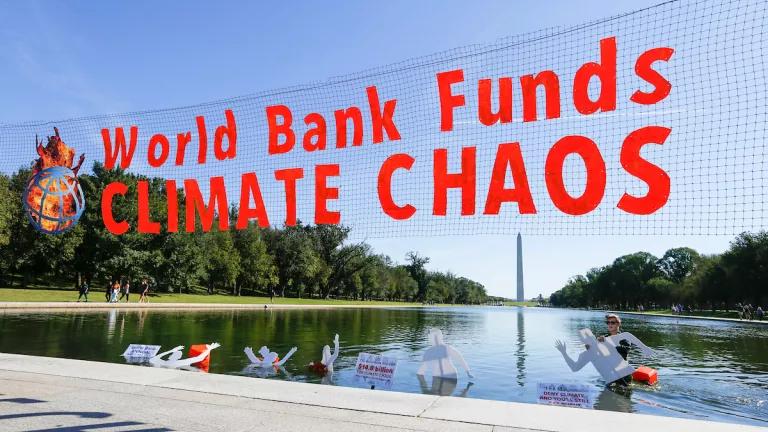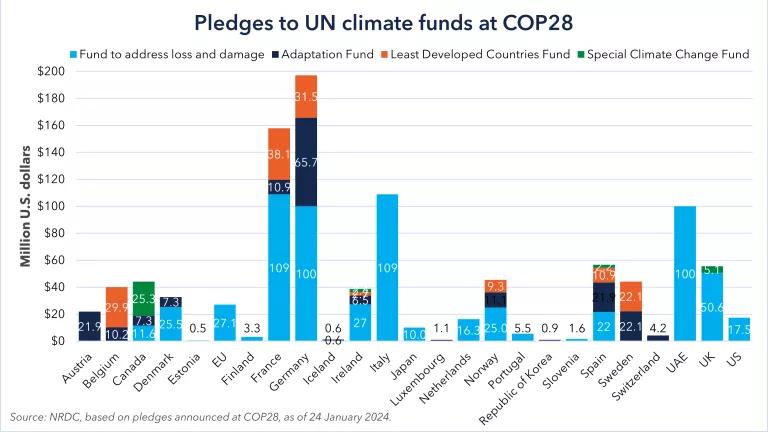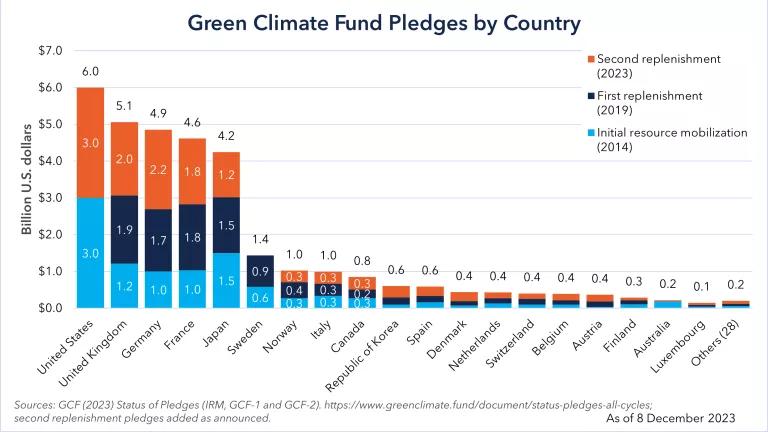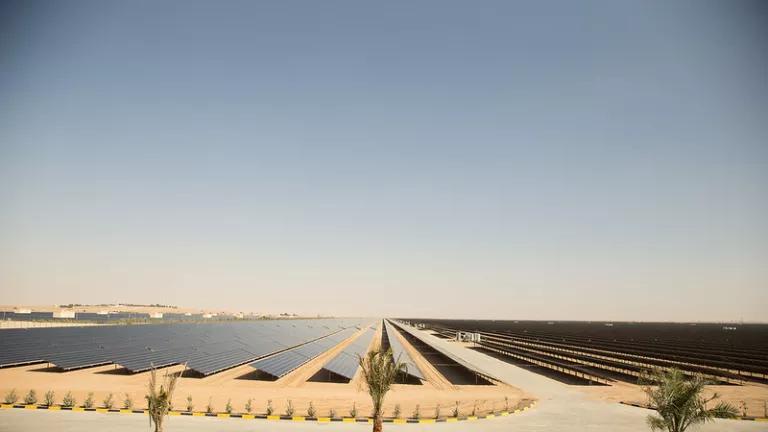The World Bank Needs to Get Serious About Reform
The World Bank needs to seriously up its game to help tackle the multiple crises the world is facing.

Activists in Washington DC protest the World Bank in October 2022
The world is facing multiple crises, including the ongoing impacts of the pandemic, global food and energy price spikes and broader inflation, and growing numbers of countries in debt distress. Looming large behind all of them is the climate crisis. The World Bank Group (henceforth World Bank), the biggest provider of international public finance to developing countries, ought to be leading the charge in addressing these challenges. But under the failed leadership of David Malpass, the World Bank has, in the words of Assistant UN Secretary-General Selwin Hart, “continue[d] to fiddle while the developing world burns.” The World Bank needs to seriously up its game to help tackle the multiple crises the world is facing, with addressing climate change prime among them.
The World Bank’s shareholder countries are putting the institution under increased pressure to make significant changes. In October 2022, Germany, the U.S., and other major funders called on World Bank management to develop an “evolution roadmap” by the end of last year. At the same time, some of the most vulnerable countries—including Barbados and the Maldives—are being increasingly vocal in calling for fundamental changes at the Bank. Calls for reforms culminated at the COP27 climate conference in November 2022, where all the world’s governments endorsed a call for MDBs, including the World Bank, to define a new vision and operational model that is fit for the purpose of addressing the global climate emergency.
In late-December, the World Bank circulated its proposed evolution roadmap to governments but did not publicly release it until mid-January. Based on what the World Bank’s leadership have come up with, it is perhaps not surprising they tried to keep it from public view. It is a roadmap to a “roadmap,” laying out a too timid and too slow pathway toward the critical reforms that are needed.
A Lack Of Urgency On the Reform Agenda
While the tone of the paper nods to the urgency for reform, the proposed timeline suggests otherwise. The document doesn’t foresee initial policy decisions being taken until its Annual Meetings in October 2023, meaning implementation won’t begin until 2024, or later. This is simply too slow. The pandemic, energy, food and debt crises are devastating lives and livelihoods now. We are in the critical decade for climate action; global greenhouse gas emissions need to peak by 2025 and be cut in half by 2030 to keep the Paris Agreement’s goal of holding global average temperature rise to 1.5°C (2.7°F) within reach. The world is facing a polycrisis and cannot afford to move at the pace the ossified bureaucracy at the World Bank is used to. We need reforms delivered soon enough that significantly more finance can flow in the next fiscal year – beginning July 1, 2023.
Proposals Nibble Around the Edges Rather Than Confront Need for Fundamental Reforms
Getting to the substance of the proposals in the paper, they are mostly a disappointing mix of navel gazing and finger pointing. The paper expounds at length about myriad World Bank mechanisms, trust funds and financial instruments that could be expanded or tweaked. No doubt some of these are doing decent work, but it is nibbling around the edges when what is needed is fundamental reform of the Bank’s overall operations to be fit for 21st century challenges. The paper discusses whether changes to the metrics the Bank uses to assess progress towards its twin goals—ending extreme poverty and promoting shared prosperity—might be needed, as well as how to integrate work on global challenges such as climate change and pandemic preparedness into its mission. These are welcome openings to discuss reforms which have the potential to increase access to concessional finance for vulnerable countries.
Simply Calling for More Funding Is Not the Answer
For most of the paper, the Bank wheels out its usual retort when under fire for poor performance: to ask for more money. The paper calls for a capital increase for the International Bank for Reconstruction and Development (IBRD), the Bank's arm than lends to middle-income countries, replenishment of the International Development Association (IDA), the arm providing concessional finance for the poorest countries, more funding for its specialist trust funds and facilities as well as potentially creating of new ones. It is essentially saying: “the problem is not us, it’s lack of funding provided by shareholder governments.” A 2020 study found that the World Bank has created 100 climate-related trust funds since 1988. The failure to deliver on climate is not for want of a new trust fund. The World Bank needs to reform its core operations, integrating climate throughout its work and making sure all its funding is aligned with the Paris Agreement’s goals (more on this below). Creating trust funds suggests they still see climate as a niche interest rather than the central development and security challenge of the 21st century. It’s certainly more headline-grabbing to launch new initiatives rather than put in the hard work to make existing mechanisms work better. But the climate finance architecture is already characterized by too many institutions with too little money to go around. Having more wallets does not make you richer.
This is not to say that new donor funding won’t be needed at some point, but when almost every institution in need of government funding is being squeezed, large and comparatively well-resourced institutions like the World Bank have a high bar to show that they are most deserving of additional public funds. There is a widely held view that multilateral development banks (MDBs) in general, and the World Bank in particular, are moving too slowly in the face of crisis, and leaving too much of their capital sitting on the sidelines by being too conservative.
The Wrong Mindset For Maximizing Existing Capital
In 2021, finance ministers from the G20, a group of twenty of the world’s biggest economies, commissioned a review of multilateral development banks’ capital adequacy frameworks – the Capital Adequacy Framework (CAF) review. MDBs fund their activities through direct capital contributions by governments and by raising additional funding from capital markets by issuing bonds. Capital adequacy measures the ability of a financial institution to meet its financial obligations (in this case, primarily to bondholders) if the entities they have lent money to (in this case, developing countries) are unable to repay what they borrowed. Despite attempts by the World Bank’s leadership to block its publication, the CAF review was released in July 2022 and contains five recommendations to squeeze more out of MDBs’ existing resources.
In their October 2022 request for a roadmap, major shareholders asked the Bank to assess each of the CAF recommendations for how they could expand the Bank’s financial capacity. While the World Bank document does indicate that they have begun evaluating how they could implement the CAF recommendations, it’s clear that the Bank’s leadership has its priorities backward. They should be looking at every option to maximize capital for developing countries to invest in addressing urgent challenges. But instead, Bank leadership are only willing to contemplate reforms that fit within redlines based on the Bank’s own financial position, rather than the needs of countries and communities it is supposed to serve. There is also a lack of urgency in contemplating CAF recommendations. For example, while some proposals for boosting financial capacity were discussed with Executive Directors in mid-December, the Bank is not planning to release a technical note on amending the equity-to-loan ratio until later this year. This is odd, because it one of the simpler reforms on the table. The World Bank has changed this ratio in the past to unleash more capital; it isn’t a novel concept that requires years of deliberation.
Silent on its Funding of Climate Destruction
When it comes to best using existing resources, the paper is conspicuously silent on the amount the Bank currently spends on fossil fuels, over $16 billion in project finance since the Paris Agreement was adopted. This funding not only drives pollution that increases the vulnerabilities of the same countries and communities the Bank is supposed to be helping, but also represents an opportunity cost; money that could have been invested in clean, sustainable energy is instead being used to invest in more climate destruction. The document does not once mention the Bank’s commitments to aligning their operations with the Paris Agreement. It’s not clear to what extent the Bank’s climate experts, who have a wealth of experience, were involved in the paper’s preparation as the document is lacking a vision on how the World Bank will play a bigger role in helping countries tackle this existential challenge.
Five Key Reforms Needed
In October 2022, leading environmental and development groups released five recommendations for how the World Bank should be reformed to enable a significant scale-up of climate action. The plan—Refreshing the World Bank Group for Climate Action—includes increased funding for climate protection and adaptation, shifting billions of dollars from fossil fuel projects into mitigation and adaptation, and enabling more large-scale innovative strategies to address the climate crisis. Such reforms will unlock greater climate action and help to address other key challenges the world is facing.
- Increase the quality and quantity of the Bank’s climate financing to ensure more funding goes to supporting greenhouse gas emissions reductions and adaptation in this critical decade for climate action. The World Bank is a key source of climate finance for the poorest countries that struggle to gain access to climate finance from other channels. Yet the World Bank is lagging other MDBs in its target for the share of funding going to climate-relevant projects. While the Asian Infrastructure Investment Bank, European Investment Bank and European Bank for Reconstruction and Development have all set 50% targets by 2025, the World Bank’s has only committed to 35%. Raising its target to 50% to match the effort of its peers could increase climate finance by over $13 billion a year in 2025, assuming current overall financing rates stay the same. Alongside increasing the scale of funding, the Bank should improve the quality of climate interventions by being more transparent about how it counts investments as climate-relevant, better aligning them with climate strategies and planning processes, and ensuring that all climate finance respects human rights, including the rights of Indigenous Peoples, promotes gender equality, has inclusive and meaningful stakeholder engagement throughout the project cycle, and complies with environmental and social safeguards. The Bank should explore more innovative finance mechanisms to better meet specific climate investment needs, such as currency risk hedging facilities, green banks, and sovereign guarantees for energy transition.
- Align all the Bank’s operations with the Paris Agreement’s goals. In addition to ramping up its climate-specific funding, the Bank needs to ensure that all of its activities are consistent with the goals agreed by every government in the world of keeping warming to 1.5℃ above pre-industrial levels, increasing peoples’ ability to adapt to the impacts of climate change, and making finance flows consistent with a pathway towards these goal. The World Bank Group should commit to aligning all of its financing arms with the Paris Agreement by mid-2023, with clear methodologies for ensuring direct investments, policy-based lending and intermediary financing are consistent with the 1.5℃ temperature goal that governments reaffirmed in the Glasgow Climate Pact last year, and that all activities build in climate resilience from the beginning. These methodologies should include specific guidance for how key sectors, such as energy, industry, and agriculture should become aligned with the Paris Agreement. In energy, the World Bank should follow the lead of the European Investment Bank that has committed to end all finance for fossil fuels, except in limited and clearly defined circumstances where a credible alternative analysis transparently and robustly proves that the poverty alleviation needs can’t be met with clean energy, that such financing is consistent with a 1.5°C pathway, and doesn’t lead to fossil fuel lock-in.
- Significantly increase the quality and quantity of adaptation finance. Globally, adaptation remains woefully underfunded, with over 90% of all climate finance for mitigation. To address this, the Paris Agreement includes a goal to achieve a balance between mitigation and adaptation finance, and the Bank has commendably committed that at least 50% of the climate finance provided by its IDA and IBRD arms will go to adaptation. This equated to nearly $13 billion in 2022. If the Bank increases its overall climate finance target, its adaptation funding could rise by over $5 billion a year. However, there remain issues around the quality of and access to this financing. Since adaptation investments don’t usually yield financial returns in the same way as, for example, renewable energy investments do, and because it’s a cost imposed on communities generally not of their own causing, the World Bank should focus on ensuring its adaptation finance is concessional (grant or very low-interest loans). In addition, several countries that are very vulnerable to climate change are ineligible to access highly concessional financing because they are classified as middle- or high-income countries. This is particularly the case for small island states that generate significant revenues from tourism yet can suffer losses of multiple times their annual GDP when hit by hurricanes. While the poorest countries need significantly increased concessional adaptation finance, the World Bank should review its eligibility criteria so that higher income but highly vulnerable countries may also access concessional funding for adaptation projects. As governments begin to seriously grapple with financing needed for loss and damage – costs faced from climate disasters when the limits of adaptation have been reached – the World Bank should be pro-active in clarifying how it distinguishes between finance for adaptation, emergency assistance, and loss and damage.
- Reform the incentive structures so that leadership and staff are encouraged to deliver on climate objectives. Too often performance metrics focus on quantity rather than quality of financing. Integrating climate indicators can provide the encouragement staff need to take the time to integrate climate considerations throughout their work.
- Raise the World Bank’s overall lending capacity. It has long been argued that MDBs in general, and the World Bank in particular, are being too conservative with their resources. Because they are backed by all the world’s major governments, they can afford to take more risk and do not need to hold as much capital in reserve in the same way a private financial institution is rightly required to by financial regulators. By putting more of their existing capital to work in smart ways, the World Bank could significantly increase funding for pressing development needs, including climate change. Implementing some or all of the recommendations from the CAF review could increase the World Bank’s overall lending capacity by tens of billions of dollars per year, all without requiring additional capital contributions by governments. The Bank should commit to implement one or more of the CAF recommendations by June 2023 and finalize implementation to realize increased lending capacity by fiscal year 2024. Capital adequacy is technical and MDBs are cautious about rushing into reforms, but the urgency of the multiple crises the world is facing require international financial institutions to rise to the moment. The World Bank should be a first mover in implementing the CAF review recommendations, paving the way for other MDBs to follow suit.
These reforms can help unlock the World Bank’s potential to do much better on climate and development. The Bank has the funding and knowledge to support transformative and innovative strategies that grapple with the full scale of the climate crisis. By using its financial heft and tools at its disposal, the World Bank could play a leading role in supporting country energy transitions, scaled-up adaptation, interventions that transform clean energy markets across multiple jurisdictions, and innovative finance structures that help mobilize more public and private finance.
Shareholders Shouldn't Stand for This: Tell Leadership to be Bold
The "evolution roadmap" the World Bank released in December could and should be contemplating the biggest set of reforms in its nearly eighty-year history. But rather than grapple with the scale of change needed to confront the unprecedented crises the world faces, the World Bank’s leadership appears to be attempting to kick major reforms into the bureaucratic long grass.
Many of the World Bank’s shareholders—the governments of the world—are calling for the institution to get in shape. Unfortunately, the evolution roadmap that World Bank’s leadership has put forward in response to these requests fails to do this. Time and again in response to calls for reform, the Bank simply reverts to calling for increased funding. Countries need to light a fire under the Bank’s leadership to do better. They can assert their influence by connecting future capital increases and replenishments to Bank getting serious about reform and showing tangible progress in delivering on climate and other development objectives.
Shareholders need to put the World Bank’s leadership on notice and call for a more serious and urgent reform agenda.
[UPDATED 1/18/2023 with link to World Bank's public release of the evolution roadmap]





